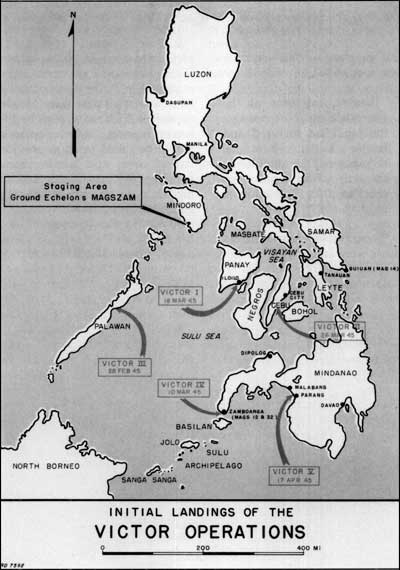| Marines in World War II Commemorative Series |
|
. . . AND A FEW MARINES: Marines in the Liberation of the Philippines by Captain John C. Chapin, USMCR (Ret) Corsair Action The two fighter groups, MAG 12 and -14, had meanwhile been equally busy. One of their more bizarre missions occurred on 23 February when four planes from MAG-12's VMF-115 spotted two small Japanese submarines on the surface near Cebu. Missing on their first attack, they returned to base, rearmed, and went after their quarry again. This time, coming in at a 20-25-foot altitude, they skipped their 1,000-pound bombs along the water's surface. One submarine was hit; "probably first submarine sunk by Corsair," the squadron reported. VMF-211 was another squadron in this group. It had been award ed a Presidential Unit Citation for its heroic, hopeless defense of Wake Island in December 1941. Now the pilots called their successor squadron the "Avengers." One of them, Major Phillip B. May, had a grim experience at this time. While attacking an enemy airfield on Mindanao on 27 February, Japanese antiaircraft fire disabled his plane. So he opened the hood and jumped, landing in a group of coconut trees about 100 yards off the runway, while his plane burned about 25 feet away. As he hit the ground, he fell and saw that his trousers were on fire and that a piece of shrapnel was embedded in his left lower leg. May later recalled:
He continued to run without stopping, falling frequently, until he finally dropped down, tired and thirsty, after an exhausting hour. Within a few minutes, he heard Japanese voices close by, yelling and screaming, and he quickly began to cover himself with grass and leaves. A Japanese soldier slowly approached, and May pulled out his pistol and lay still and ready. The man passed within five feet of him, but did not look down to where he was lying. Six or seven others in the searching squad were spread out over a large area. Finally they got into a truck and drove off. Hiding there until dark, May set out on foot again and eventually came to Davao Gulf. His story continued:
Reaching the far shore of the gulf, he started walking to try to find some fresh water, as he was now very thirsty. Finally he came to a hut with three women, and he kept repeating to them, "I am your friend. I am an American." They listened to his story, and then got him some fresh water, insisting that he go to their hut and rest. The women then informed him that the Japanese were about three kilometers away, but the guerrillas were to the north, and they would help him get to them. May was delighted, as he wanted to get back to friendly troops as soon as possible. The next day two men volunteered to lead him to the guerrillas, so they started out about noon.
All along the beach friendly Filipinos came out to see him and try to talk with him, for he was the first American they had seen in four years. At one point a whole village turned out to welcome him; the mayor made a speech and the villagers clapped and laughed and came up to shake his hand. They were overjoyed to know that the Americans would soon drive the Japanese away from the Davao Gulf area. The mayor then sent runners to the guerrilla lines to have an escort take May to their leader. The pilot's account went on:
The next morning he was taken to the guerrilla's headquarters where a doctor treated his leg. They notified the U.S. Navy which picked him up three days later in a Martin Mariner PBM (twin-engined seaplane), and returned him to his base at Tacloban. May flew back a few days later to bring some badly needed medical supplies to "his guerrillas." His story ended on a horrific note:
These varied experiences of pilots were only part of the wide ranging activities of the two Corsair groups flying out of Leyte and Samar. During just the month of February, MAG-14 flew 1,944 sorties and destroyed 12 Japanese planes on the ground, as well as 90 enemy buildings and 20 vehicles. Similarly, MAG-12, along with its continued strikes on Negros and Cebu, began reaching out a long 320 miles to attack targets on Mindanao. These missions gave it a total of 1,838 sorties in February.
|




